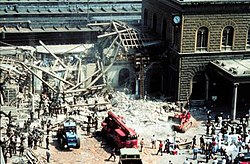This article needs additional citations for verification .(August 2015) |
This article needs to be updated.(September 2020) |
Bologna Centrale | |||||||||||
|---|---|---|---|---|---|---|---|---|---|---|---|
 View of the station building in 2006 | |||||||||||
| General information | |||||||||||
| Location | Piazza delle Medaglie d'Oro 40121 Bologna Italy | ||||||||||
| Coordinates | 44°30′21″N11°20′30″E / 44.50583°N 11.34167°E | ||||||||||
| Owned by | Rete Ferroviaria Italiana | ||||||||||
| Operated by | Grandi Stazioni | ||||||||||
| Line(s) | |||||||||||
| Distance | 96.908 kilometres (60.216 mi) from Firenze Santa Maria Novella | ||||||||||
| Platforms | 27 | ||||||||||
| Construction | |||||||||||
| Architect | Gaetano Ratti | ||||||||||
| Other information | |||||||||||
| IATA code | IBT | ||||||||||
| History | |||||||||||
| Opened | 1864 | ||||||||||
| Services | |||||||||||
| |||||||||||
| |||||||||||
Bologna Centrale is the main railway station in Bologna, Italy. The station is situated at the northern edge of the city centre. It is located at the southern end of the Milan-Bologna high-speed line, which opened on 13 December 2008, and the northern end of three lines between Bologna and Florence: the original Bologna-Florence line through Porretta Terme and Pistoia; the Bologna–Florence Direttissima via Prato, which opened on 22 April 1934 and the Bologna-Florence high-speed line, which opened to traffic on 13 December 2009.
Contents
- Station
- Bologna Centrale (AV)
- History
- 1980 terrorist bombing
- Train services
- Domestic (High-speed) AV Station
- Domestic (High-speed)
- Domestic
- Cross-border
- Nearby public transport
- See also
- References
- External links
Bologna Centrale is the fifth-busiest in Italy in terms of passenger movements (about 58 million passengers per year). It is, however, one of the busiest, along with Rome Termini Station, for the number of train movements per day (about 800). [1] [2]
The station is linked to Bologna Guglielmo Marconi Airport by the Marconi Express, a direct monorail line 5-kilometre (3.1 mi) in length, [3] launched on 18 November 2020. [4]



